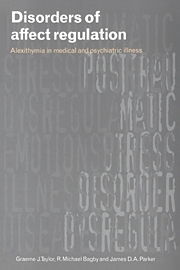Book contents
- Frontmatter
- Contents
- Foreword
- Acknowledgments
- Acknowledgment of permission for use of material
- Introduction
- 1 The development and regulation of affects
- 2 Affect dysregulation and alexithymia
- 3 Measurement and validation of the alexithymia construct
- 4 Relations between alexithymia, personality, and affects
- 5 The neurobiology of emotion, affect regulation, and alexithymia
- 6 Somatoform disorders
- 7 Anxiety and depressive disorders and a note on personality disorders
- 8 Substance use disorders
- 9 Eating disorders
- 10 Affects and alexithymia in medical illness and disease
- 11 Treatment considerations
- 12 Future directions
- Appendix
- References
- Index
9 - Eating disorders
Published online by Cambridge University Press: 21 September 2009
- Frontmatter
- Contents
- Foreword
- Acknowledgments
- Acknowledgment of permission for use of material
- Introduction
- 1 The development and regulation of affects
- 2 Affect dysregulation and alexithymia
- 3 Measurement and validation of the alexithymia construct
- 4 Relations between alexithymia, personality, and affects
- 5 The neurobiology of emotion, affect regulation, and alexithymia
- 6 Somatoform disorders
- 7 Anxiety and depressive disorders and a note on personality disorders
- 8 Substance use disorders
- 9 Eating disorders
- 10 Affects and alexithymia in medical illness and disease
- 11 Treatment considerations
- 12 Future directions
- Appendix
- References
- Index
Summary
During the past 15 years, eating disorders have been the focus of increasing attention from both the general public and from medical and psychiatric researchers. While once diagnosed rather rarely, anorexia nervosa and the closely related syndrome known as bulimia nervosa are now commonly diagnosed and have become an important health problem in Western countries. Both disorders typically follow a chronic, frequently relapsing course and often lead to medical complications that produce significant morbidity and sometimes result in death. Indeed, long-term outcome studies indicate that up to 50% of anorexic patients relapse even after successful treatment in hospital (Hsu, 1980), and that between 5% and 22% of patients with eating disorders die from medical complications or commit suicide (Bruch, 1971; Deter & Herzog, 1994; Herzog, Keller & Lavori, 1988).
The extent of this public health problem is evidenced by incidence rates of around 1% to 2% for both anorexia nervosa and bulimia nervosa among adolescent and young adult females, which is the population most at risk for developing eating disorders (Crisp, Palmer & Kalucy, 1976; Drewnowski, Yee & Krahn, 1988; Fairburn & Beglin, 1990; Zerbe, 1992). Milder forms of these disorders occur in about 5% of the female population, although bulimic symptomatology may be reported by as many as 10% to 15% of high school and college-age females (Drewnowski et al., 1994; Herzog, 1991).
- Type
- Chapter
- Information
- Disorders of Affect RegulationAlexithymia in Medical and Psychiatric Illness, pp. 190 - 215Publisher: Cambridge University PressPrint publication year: 1997
- 5
- Cited by



